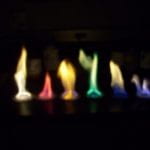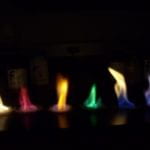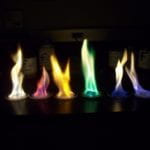DESCRIPTION:
When different ionic compounds are heated, electrons around the metal atom become excited and jump energy levels. When the electrons fall back to ground state they release light and heat energy. The amount of energy released determined the wavelength and color of the light released, resulting in different colored flames.
TOPICS COVERED:
– light
– excited states
– combustion
– wavelengths of light
– color change
– chemical change
– thermal conduction
– energy transformations
MATERIALS NEEDED:
– 6 Petri dish
– 95% ethanol
– NaCl (burns yellow orange)
– CuCl2 . 2H2O or boric acid (burns green)
– KNO3 (burns lavender)
– SrCl2 . 6H2O (burns red)
– MnCl2 . 4H2O (burns with white sparks)
– matches or a lighter
PROCEDURE:
1. Place some of each solid into an evaporating dish
2. Squirt ethanol on the solid with a disposable pipet
3. Light the ethanol on fire
ADDITIONAL COMMENTS:
The colors may not change at first, but once the flame hits the solid they will. The dishes can be lined up: manganese, strontium, sodium, copper, plain ethanol, and potassium to create a rainbow of flames. The dishes can be covered and reused a few times. Strontium doesn’t last as long as others, so it will need to be refreshed with some new solid each time/replaced as a whole more often.
SAFETY:
Make sure the ethanol container is far from the evaporating dishes before lighting, also caution should be taken with matches, and goggles should be worn at all times.
REFERENCES:
Silberberg, M.S. Principles of General Chemistry; McGraw-Hill: Boston, 2007; pp 204, 217.
STORY:
You could ask the students what color fire is, and then tell them you’re going to prove them wrong.
Students can relate to absorbing energy. Ask them what happens when they eat a lot of sugar or drink caffeine. They get energy and get excited. How do they give off that energy? By talking, fidgeting, etc. The same goes with electrons. They absorbed thermal energy from the flames, but they give off their energy as different colors of light.
This problem set practices calculating the number of photons in a sample, the frequency of light emitted, and the energy of that light.
This lesson plan outlines the wave-particle duality of light as well as the equations: c = λν and E = hν.


